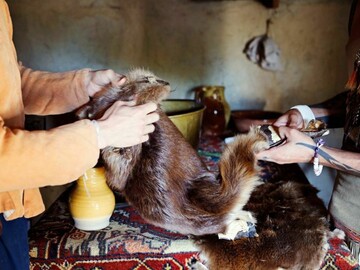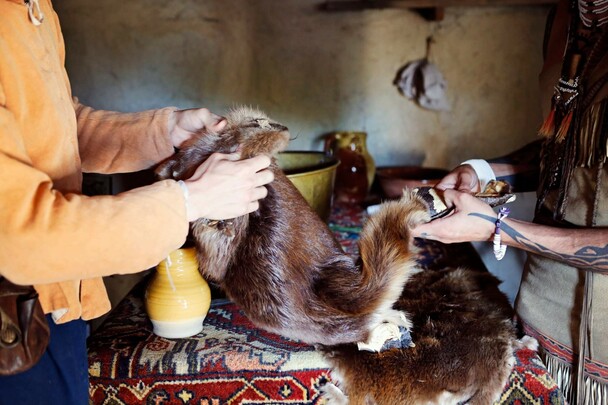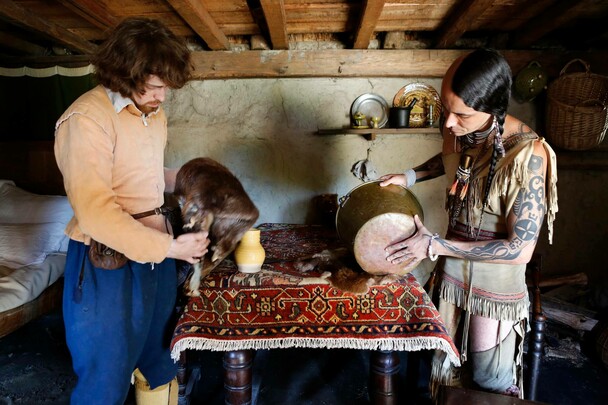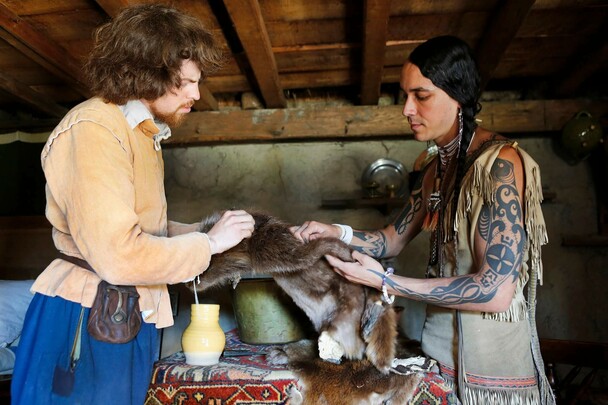Excerpt from speech made by Narragansett sachem Miantonomi
- Date
- c.1640
- Material
- Paper, Speech
- Author/Maker
- Spoken by Narragansett sachem Miantonomi. Recorded by Lion Gardner (1599–1663)
- Source
- Collections of the Massachusetts Historical Society, Third Series, Volume 3 (1833)

Description
Colonial expansion into Native homelands across New England dramatically increased during a period now known as “the Great Migration.” Between 1629 and 1643, over 20,000 English men, women, and children would emigrate to the Puritan-led Massachusetts Bay Colony leading to the establishment of dozens of new towns and independently governed colonies including Rhode Island Colony and Providence Plantations (1636), Connecticut Colony (1636); and New Hampshire plantations (1623 - 1640). The Dutch colony at Manahatta or Nieuw Amsterdam (known today as New York City) had also been established in 1624. This rapid expansion of European colonial presence had a profound impact on Wampanoag, Narragansett, Massachusetts, Nipmuc, Pequot, Mohegan and other tribal nations across southeastern New England. Efforts to engage diplomatically or economically varied widely at the broader colonial government/sachemship and local interpersonal levels; however, confrontations over land, livestock, and trade pushed fragile relationships to the breaking point.1
Tensions were particularly high in the Pequot homelands - an area of southeastern Connecticut that today includes Groton, Ledyard, Stonington, and North Stonington, as well as southern portions of Preston and Griswold. At the turn of the 17th century, it is estimated that the Pequot population was at least 8,000 people across 15-20 villages. By 1634 the population had dropped to an estimated 4,000.2 Dutch fur traders enlisted the Pequot to help the Dutch dominate the European fur market as early as 1611. The Pequot seized the opportunity to expand their power and authority in the region by building an expanded tributary confederacy with neighboring tribal communities through coercion, intermarriage, warfare, and diplomacy. The arrival of the English in the 1630s shifted the balance of power. English fur traders - including the colonists at Plymouth - vied to dominate the fur trade and break the Dutch-Pequot hold on the Connecticut River and Long Island Sound while the Pequot wanted to retain their economic and political power and dominance. In 1635, Willliam Bradford wrote to magistrates in Boston expressing his frustration that Massachusetts Bay colonists were settling on the Connecticut River where Plymouth had already staked a claim and began fur trading with the Pequot. Bradford wrote: “where as you say God, in his providence, cast you upon the lands, we told you before, and (upon this occasion) must now tell you still, that our mind is otherwise - and that you cast rather a partial, of not a covetous eye upon that which is your neighbor’s and not yours.”3
Members of the Pequot’s tributary confederacy allied themselves with the English in an attempt to liberate themselves from Pequot control, further escalating tensions and ultimately leading to violence. While the deaths of trader John Stowe and his crew in 1634 is often cited as the cause of the Pequot War (1637-1638), according to Pequot historians at the Mashantucket Pequot Museum: “these deaths were the culmination of decades of tension between Native tribes further stressed by the arrival of the Dutch and English.”4
Massachusetts governor John Winthrop requested Plymouth provide military support against the Pequots in 1637. William Bradford hedged, infuriating Winthrop who responded: "yet if [the Pequots] prevail, will surely pursue his advantage, to the rooting out of the whole nation; therefore when we desired your help, we did it not without respect to your own safety, as ours.”5On June 7, 1637, Plymouth’s General Court agreed “that the colony of New Plymouth shall send forth aid to assist them of Massachusett Bay and Connecticut in the wars against the [Pequot] Indians in revenge of the innocent blood of the English which the said [Pequots] have barbarously shed, and refuse to give satisfaction for.” 644 men volunteered, but before they could begin their march to Connecticut, Winthrop had written again to describe what has come to be known as the “Massacre at Mystic” wherein 400-600 Pequot - mostly women, children, and the elderly - were slaughtered and their fortified settlement burned to the ground.
The war ended in 1638 with the Treaty of Hartford made between Governor of Connecticut Colony, John Haynes along with Roger Ludlow and Edward Hopkins; the Narragansett sachem, Miantonomi; and the Mohegan sachem, Uncas. The treaty clearly favored English interests and further subjugated the Narragansett and Mohegan. Terms of the treaty included:
First, there is a peace and familiarity made between the said Miantonomo and the Narragansett Indians and the said Poquiam and Mohegan Indians and all former injuries and wrongs offered each to other remitted and buried and never to be renewed anymore from henceforth…It is agreed if there fall out injuries and wrongs for future to be done or committed each to other or their men, they shall not presently revenge it, but they are to appeal to the English…[Third], it is agreed and a conclusion of peace and friendship made between the said Miantonomo and the said Narragansetts and the said Poquiam and said Mohegans as long as they carry themselves orderly and give no just cause of offense and that they, nor either of them, do shelter any that may be enemies to the English that shall or formerly have had hand in murdering or killing any English man or woman or consenting thereunto…Fourth, and whereas there be or is reported for to be said Narragansetts and Mohegans, two hundred Pequots living that are men besides squaws and papooses, the English do give unto Miantonomo and the Narragansetts to make up the number of eighty with the eleven they have already and to Poquiam his number and that after they, the Pequots, shall be divided as aforesaid, shall no more be called Pequots but Narragansetts and Mohegans...and shall not suffer them for to live in the country that was formerly theirs but now is the English by conquest.7
Two years after the Treaty of Hartford, Miantonomi’s experiences in the Pequot War and its aftermath drove him to foster a new inter-tribal alliance against the English. The Narragansett sachem visited Wyandanch, the sachem of the Montaukett in what is today known as Suffolk County, New York. Lion Gardner recorded Miantonomi’s speech at Montaukett in which the sachem outlines his feelings about English colonial expansion and its potential consequences for Native people if left unchallenged. Gardner and Wyandanch reported what they heard to the Connecticut Colony and asked for help. Miantonomi was captured and executed in 1641.
Transcription
Brethren and friends, for so are we all Indians as the English are, and say brother to one another; so we must be one as they are, otherwise we shall be all gone shortly, for you know our fathers had plenty of deer and skins, our plains were full of deer, as also our woods, and of turkies, and our coves full of fish and fowl. But these English having gotten our land, they with scythes cut down the grass, and with axes fell the trees; their cows and horses eat the grass, and their hogs spoil our clam banks, and we shall all be starved; therefore it is best for you to do as we, for we are all the Sachems frome east to west, both Moquakues and Mohauks join with us, and we are all resolved to fall upon them all, at one appointed day.
Media
Gardener's Pequot Warres
View PDFTranscription
Brethren and friends, for so are we all Indians as the English are, and say brother to one another; so we must be one as they are, otherwise we shall be all gone shortly, for you know our fathers had plenty of deer and skins, our plains were full of deer, as also our woods, and of turkies, and our coves full of fish and fowl. But these English having gotten our land, they with scythes cut down the grass, and with axes fell the trees; their cows and horses eat the grass, and their hogs spoil our clam banks, and we shall all be starved; therefore it is best for you to do as we, for we are all the Sachems frome east to west, both Moquakues and Mohauks joing with us, and we are all resolved to fall upon them all, at one appointed day.
Discussion Questions
-
Who is Miantonomi speaking to?
-
What is Miantonomi trying to achieve with this speech?
-
What do you picture in your mind when you read (or listen to) this speech by Miantonomi?
-
How do you think Miantonomi is feeling in this moment? Why do you say that?
-
What impact did the Pequot War and the Treaty of Hartford have on Miantonomi’s decision to establish a new intertribal alliance?
-
What does Miantonomi assert are the major issues creating tensions between the Narragansett and the English colonists?
-
What could be the outcome if the English colonists are allowed to continue expanding?
-
How would you respond to the problems facing Miantonomi and the Narragansett people?
Footnotes
- 1Pequot War - Connecticut History - a CTHumanities Project. Accessed 4/29/23.
- 2“History of the Pequot War,” Mashantucket Pequot Museum - Battlefields of the Pequot War. Accessed 4/29/23.
- 3 George Willison,The Pilgrim Reader (New York: Doubleday and Company, 1953) pg. 407
- 4“History of the Pequot War,” Mashantucket Pequot Museum - Battlefields of the Pequot War. Accessed 4/29/23.
- 5 William Bradford, Of Plimoth Plantation. (Boston: Conserved and digitized by the State Library of Massachusetts, 2014). pg. 220
- 6 Plymouth Colony Records, Vol. I pg. 116
- 7 Treaty of Hartford (1638) Native Northeast Portal. Accessed 4/29/23.


